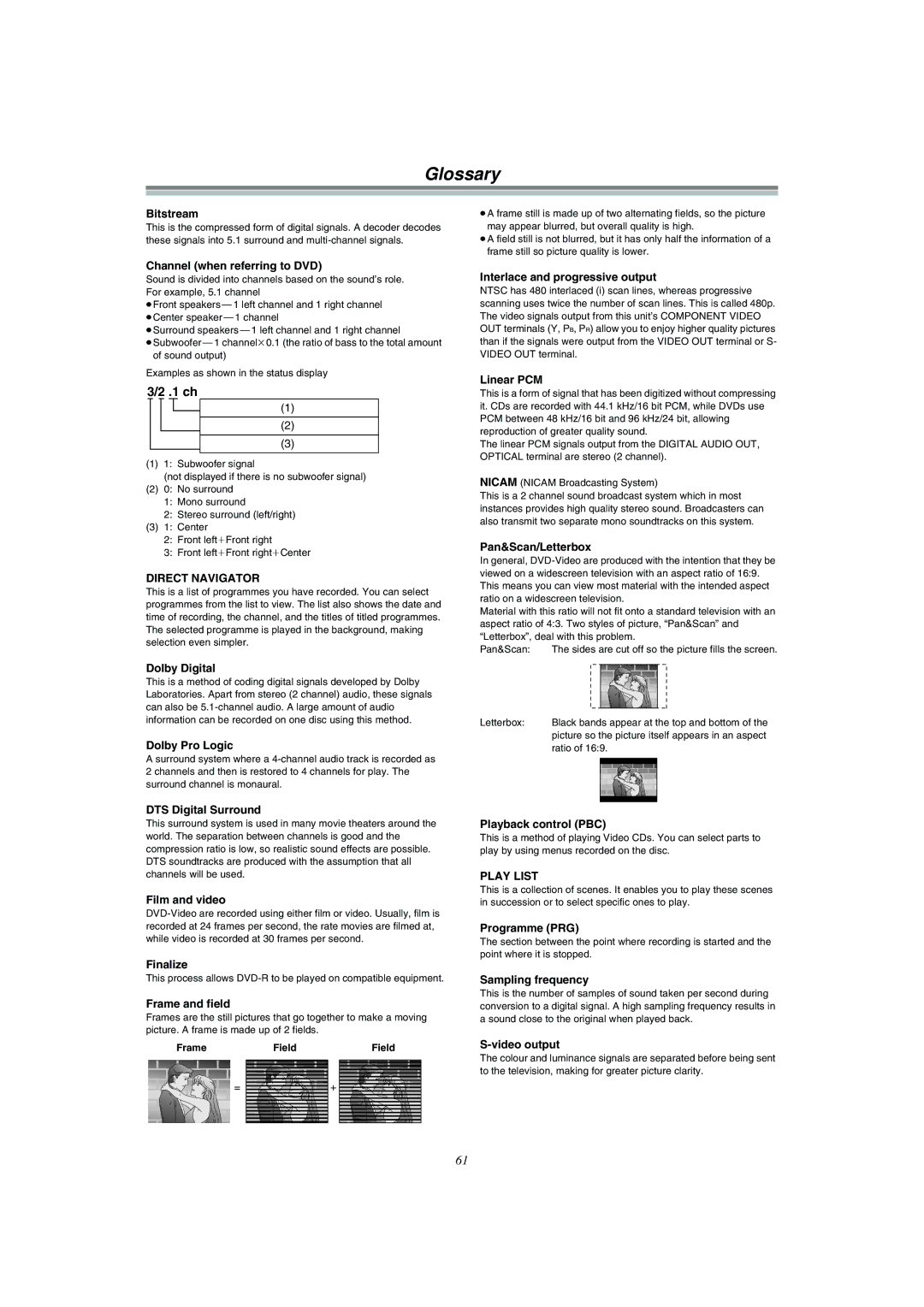
Glossary
Bitstream
This is the compressed form of digital signals. A decoder decodes these signals into 5.1 surround and
Channel (when referring to DVD)
Sound is divided into channels based on the sound’s role. For example, 5.1 channel
≥Front speakers — 1 left channel and 1 right channel ≥Center speaker — 1 channel
≥Surround speakers — 1 left channel and 1 right channel
≥Subwoofer — 1 channelk0.1 (the ratio of bass to the total amount of sound output)
Examples as shown in the status display
3/2 .1 ch
(1)
(2)
(3)
(1)1: Subwoofer signal
(not displayed if there is no subwoofer signal)
(2)0: No surround
1:Mono surround
2:Stereo surround (left/right)
(3)1: Center
2:Front leftiFront right
3:Front leftiFront rightiCenter
DIRECT NAVIGATOR
This is a list of programmes you have recorded. You can select programmes from the list to view. The list also shows the date and time of recording, the channel, and the titles of titled programmes. The selected programme is played in the background, making selection even simpler.
Dolby Digital
This is a method of coding digital signals developed by Dolby Laboratories. Apart from stereo (2 channel) audio, these signals can also be
Dolby Pro Logic
A surround system where a
DTS Digital Surround
This surround system is used in many movie theaters around the world. The separation between channels is good and the compression ratio is low, so realistic sound effects are possible. DTS soundtracks are produced with the assumption that all channels will be used.
Film and video
Finalize
This process allows
Frame and field
Frames are the still pictures that go together to make a moving picture. A frame is made up of 2 fields.
Frame | Field | Field |
| = | + |
≥A frame still is made up of two alternating fields, so the picture may appear blurred, but overall quality is high.
≥A field still is not blurred, but it has only half the information of a frame still so picture quality is lower.
Interlace and progressive output
NTSC has 480 interlaced (i) scan lines, whereas progressive scanning uses twice the number of scan lines. This is called 480p. The video signals output from this unit’s COMPONENT VIDEO OUT terminals (Y, PB, PR) allow you to enjoy higher quality pictures than if the signals were output from the VIDEO OUT terminal or S- VIDEO OUT terminal.
Linear PCM
This is a form of signal that has been digitized without compressing it. CDs are recorded with 44.1 kHz/16 bit PCM, while DVDs use PCM between 48 kHz/16 bit and 96 kHz/24 bit, allowing reproduction of greater quality sound.
The linear PCM signals output from the DIGITAL AUDIO OUT, OPTICAL terminal are stereo (2 channel).
NICAM (NICAM Broadcasting System)
This is a 2 channel sound broadcast system which in most instances provides high quality stereo sound. Broadcasters can also transmit two separate mono soundtracks on this system.
Pan&Scan/Letterbox
In general,
Material with this ratio will not fit onto a standard television with an aspect ratio of 4:3. Two styles of picture, “Pan&Scan” and “Letterbox”, deal with this problem.
Pan&Scan: | The sides are cut off so the picture fills the screen. | |||||||||||||||||
|
|
|
|
|
|
|
|
|
|
|
|
|
|
|
|
|
|
|
|
|
|
|
|
|
|
|
|
|
|
|
|
|
|
|
|
|
|
|
|
|
|
|
|
|
|
|
|
|
|
|
|
|
|
|
|
|
|
|
|
|
|
|
|
|
|
|
|
|
|
|
|
|
|
|
|
|
|
|
|
|
|
|
|
|
|
|
|
|
|
|
|
|
|
|
|
|
|
|
|
|
|
|
|
|
|
|
|
|
|
|
|
|
|
|
|
|
|
|
|
|
|
|
|
|
|
|
|
|
|
|
|
|
|
|
|
|
|
|
|
|
|
|
|
|
|
|
|
|
|
|
|
|
|
|
|
|
|
|
|
|
|
|
|
|
|
|
|
|
|
|
|
|
|
|
|
|
|
|
|
|
|
|
|
|
|
|
|
|
|
|
|
|
|
|
|
|
|
|
|
|
|
|
|
|
|
|
|
|
|
|
|
|
|
|
|
|
|
|
|
|
|
|
|
|
|
|
|
|
|
|
|
|
|
|
|
|
|
|
|
|
|
|
|
|
|
|
Letterbox: | Black bands appear at the top and bottom of the | ||
| picture so the picture itself appears in an aspect | ||
| ratio of 16:9. | ||
|
|
|
|
|
|
|
|
Playback control (PBC)
This is a method of playing Video CDs. You can select parts to play by using menus recorded on the disc.
PLAY LIST
This is a collection of scenes. It enables you to play these scenes in succession or to select specific ones to play.
Programme (PRG)
The section between the point where recording is started and the point where it is stopped.
Sampling frequency
This is the number of samples of sound taken per second during conversion to a digital signal. A high sampling frequency results in a sound close to the original when played back.
S-video output
The colour and luminance signals are separated before being sent to the television, making for greater picture clarity.
61
